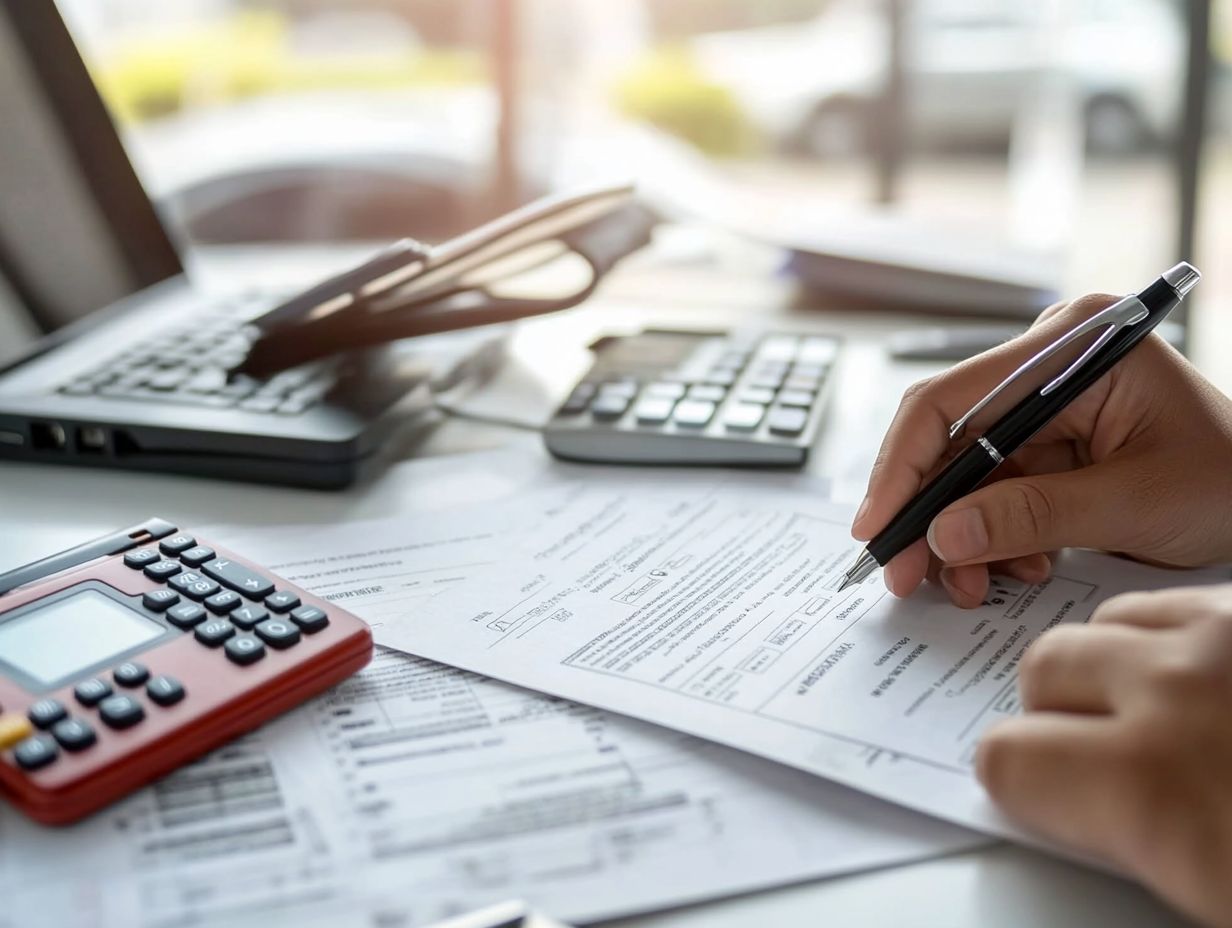How to Assess Your Coverage After an Accident
Understanding insurance coverage is essential, particularly when you find yourself navigating the aftermath of an accident. This article unpacks the different types of insurance coverage and their specific roles. It will guide you in evaluating your personal needs.
It details the first steps to take after an accident, how to report it effectively to your insurance company, and underscores the importance of reviewing your policy. It also explores how to adjust your coverage to better align with your changing circumstances. Keep reading to gain the tools you need to manage your insurance wisely.
Contents
- Key Takeaways:
- Why Your Insurance Coverage Matters
- Assessing Your Coverage Needs
- Steps to Take After an Accident
- Evaluating Your Coverage After an Accident
- Making Adjustments to Your Coverage
- Frequently Asked Questions
- What should I do first after being involved in an accident?
- How do I assess my coverage after an accident?
- Will my insurance cover all the costs of the accident?
- What if I don’t have enough coverage for the accident?
- Can I make changes to my coverage after an accident?
- What steps can I take to prevent being underinsured in the future?
Key Takeaways:

Here are some key takeaways: First, understand the types of insurance coverage to ensure you have adequate protection. Next, consider your assets, driving habits, and budget when evaluating your needs. For a deeper understanding, refer to this guide on how to identify your coverage needs. Lastly, take immediate action after an accident to protect yourself and report the incident to your insurer.
Why Your Insurance Coverage Matters
Understanding your insurance coverage is essential for you as a driver in California, as it shields you from the financial risks linked to vehicle accidents.
Each policy offers a range of coverage levels from liability (covers damages you cause to others) to comprehensive and collision ensuring you re well-prepared to handle damages, injuries, and other expenses that might arise post-accident.
By familiarizing yourself with the specifics of your insurance provisions, limits, and necessary adjustments, you can enhance your peace of mind and effectively safeguard your rights as a policyholder.
Types of Coverage and Their Purposes
As a vehicle owner, you have access to several types of insurance coverage, each designed to address the unique risks that come with driving.
Take liability coverage for example. It protects you from costs related to injuries or damages inflicted on others in the event of an accident, offering you peace of mind when the unexpected happens. Next, there s comprehensive coverage, which acts as your safety net against non-collision incidents like theft or natural disasters, ensuring you re covered when life throws a curveball your way.
Don t overlook collision coverage, either. This crucial protection covers the expenses associated with damage to your vehicle from collisions with other vehicles or objects. Personal injury protection (PIP) helps cover medical expenses resulting from accidents, so you and your passengers can receive the necessary care without the weight of financial burden.
Understanding these various coverage types is essential for you to select the policy that best aligns with your needs and lifestyle.
Assessing Your Coverage Needs
Assessing your coverage needs is vital to ensure you have protection that is perfectly tailored to your unique situation, including the type of vehicle you own and your driving habits. Understanding how to recognize the value of your coverage can help in this process.
This process requires a careful evaluation of your financial obligations, potential risks, and the level of coverage that will best safeguard your interests should an accident or claim arise.
By gaining a thorough understanding of your needs, you can make informed decisions about the insurance policies that will offer you the most comprehensive protection.
Factors to Consider
When you evaluate your insurance coverage needs, it’s essential to consider several key factors to ensure you have the protection and financial security you desire in case of an accident.
First, think about the type of vehicle you own whether it s a compact car or an SUV because this can significantly influence both the cost and type of coverage you require. Your driving habits matter too; if you regularly embark on long commutes or enjoy weekend road trips, those patterns will play a vital role in determining the protections you need.
The location where you live also comes into play, as it can affect the likelihood of accidents or theft, making tailored coverage a necessity. Lastly, consider your individual financial situation, including your income and any responsibilities you have for dependents. This assessment will help you decide how much coverage is not only necessary but also affordable, keeping your budget in check without sacrificing essential protection.
Steps to Take After an Accident

After an accident, knowing what to do can greatly affect your insurance claim. You want to secure fair compensation for damages and injuries.
It’s crucial to report the accident to the police and gather essential documentation. Engage in clear communication with your insurance company while following the guidelines from the California Department of Insurance.
By following these steps, you can protect your rights and ensure a smoother process for handling claims and expenses related to the accident.
Immediate Actions to Protect Yourself
Act quickly to protect your interests! Taking immediate action after an accident is essential to ensure you re prepared for potential claims or legal issues.
- First, check for injuries among everyone involved. This will guide how urgent your response should be.
- Once safety is assured, exchanging identification with the other drivers is crucial. It fosters transparency and paves the way for smoother communication regarding insurance claims.
Don t overlook the importance of documenting the scene. Snap photographs and jot down key details like the location, time, and circumstances surrounding the accident.
Gathering witness information strengthens your case. It creates a detailed account of events that can prove invaluable in disputes.
Keep detailed records and be prepared. This approach is key to protecting your interests after an accident.
Reporting the Accident to Your Insurance Company
Reporting the accident to your insurance company without delay is a pivotal step in the claims journey. This can significantly influence your coverage and compensation outcomes.
When you take the initiative to make this report, providing precise information about the incident is essential. Include the exact time and location of the accident, along with details about all parties involved, including drivers and any potential witnesses.
Thorough documentation is crucial. Sharing photographs of the damages, a copy of the police report, and any eyewitness statements can greatly bolster your claim.
Effective communication with the claims adjuster is vital. Being clear and honest helps you navigate any inquiries or concerns during the review process.
Evaluating Your Coverage After an Accident
Evaluating your insurance coverage after an accident helps you understand how well your policy meets your needs. For a deeper insight, consider how to assess your coverage needs based on driving habits, which highlights what adjustments might be necessary for adequate protection moving forward.
This assessment should involve a comprehensive review of your policy, including how to reassess your coverage annually, coverage limits, and the extent of damages incurred.
Consider the financial implications related to repairs, medical expenses, and potential settlements. By carefully examining these factors, you can ensure that you are not underinsured for future incidents.
Reviewing Your Policy and Coverage Limits
Reviewing your insurance policy and coverage limits is essential. This step assesses whether your current plan adequately shields you from future accidents.
It s not merely about crunching numbers; grasping the specific elements of the policy is crucial. Key aspects like deductibles, premium costs, and types of coverage significantly impact the effectiveness of your protection.
As a policyholder, pay close attention to exclusions that could leave you exposed in certain scenarios. A thorough evaluation of these factors ensures comprehensive coverage, granting you the peace of mind you deserve.
Identifying any gaps in your protection is vital. These gaps could lead to costly out-of-pocket expenses when unexpected events arise. Thus, adopting an informed approach is essential for any responsible policyholder seeking solid security.
Assessing the Damage and Cost of Repairs

Assessing damage and estimating repair costs after an accident are crucial steps in the claims process. These steps can significantly impact your financial responsibilities and the compensation you may secure from your insurance company.
By taking a systematic approach, you ensure accurate estimates and create essential documentation for your insurer. After a collision, visit multiple auto-body repair shops to gather a variety of estimates. These estimates should detail the necessary repairs, parts needed, and labor costs, giving you a comprehensive view of your vehicle s condition.
Keep all invoices, photos of the damage, and any expert opinions handy. When you talk to your insurance agent, present this documentation clearly and concisely. Highlight how it aligns with your policy coverage. Organized communication can significantly streamline the claims process and help you secure the compensation you deserve.
Making Adjustments to Your Coverage
Adjusting your insurance coverage is crucial to ensure that your policy reflects your current needs. This adjustment offers strong protection against potential risks.
After evaluating your coverage and assessing your situation following an accident, you might discover it s time to increase your coverage limits, modify your deductible, or even include additional provisions like uninsured motorist coverage. This type of coverage protects you if you’re in an accident with someone who doesn’t have insurance.
These strategic adjustments can enhance your peace of mind while on the road don’t wait to make these updates!
Updating Your Policy and Coverage Limits
Updating your insurance policy and coverage limits is essential. This step ensures your protections align with your current circumstances and liabilities.
This process typically requires reviewing your existing coverage and identifying any gaps. These gaps might arise from changes like acquiring new assets, starting a business, or relocating. Various factors, such as fluctuating market conditions or significant life events like marriage or the birth of a child, often signal the need for updates.
It is just as crucial to communicate these changes with your insurance provider. You may need to schedule a consultation or submit a formal request to discuss your updated needs. Ensuring clarity in these conversations can lead to a more tailored insurance plan that effectively safeguards your interests.
Frequently Asked Questions
What should I do first after being involved in an accident?
The first thing you should do is ensure the safety of yourself and others involved. Once everyone is out of harm’s way, begin assessing your coverage.
How do I assess my coverage after an accident?

Start by reviewing your insurance policy and understanding your coverage limits. Then, gather all relevant information and documents related to the accident, such as police reports and medical bills.
Will my insurance cover all the costs of the accident?
It depends on the type of coverage you have. Liability coverage will only cover damages to the other party involved. Collision coverage will cover damages to your own vehicle, while comprehensive coverage may also cover non-collision related damages.
What if I don’t have enough coverage for the accident?
If you do not have enough coverage to cover the costs of the accident, you may be personally liable for the remaining expenses. Regularly review and update your coverage to avoid being underinsured.
Can I make changes to my coverage after an accident?
Yes, you can make changes to your coverage at any time. However, it may affect your premiums and coverage limits. It is best to consult with your insurance provider before making any changes.
What steps can I take to prevent being underinsured in the future?
Regularly review your insurance policy and update your coverage limits to ensure they align with your current needs. You may also consider adding additional coverage options, such as umbrella insurance, for extra protection.
Contact your insurance provider today for a personalized review of your coverage. Take action to ensure your financial security!






